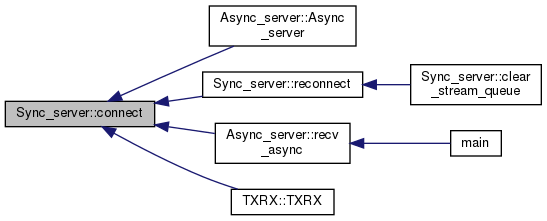 |
USRP_Server
2.0
A flexible, GPU-accelerated radio-frequency readout software.
|
 |
USRP_Server
2.0
A flexible, GPU-accelerated radio-frequency readout software.
|
#include <USRP_server_network.hpp>

Public Member Functions | |
| Sync_server (rx_queue *init_stream_queue, preallocator< float2 > *init_memory, bool init_passthrough=false) | |
| void | update_pointers (rx_queue *init_stream_queue, preallocator< float2 > *init_memory) |
| void | connect (int init_tcp_port) |
| void | reconnect (int init_tcp_port) |
| bool | start (param *current_settings) |
| bool | stop (bool force=false) |
| bool | check_status () |
| int | clear_stream_queue (rx_queue *q, preallocator< float2 > *memory) |
Public Attributes | |
| std::atomic< bool > | NET_IS_CONNECTED |
| std::atomic< bool > | NET_IS_STREAMING |
| bool | NEED_RECONNECT = false |
| bool | verbose |
| bool | passthrough |
| rx_queue * | stream_queue |
| rx_queue * | out_queue |
| preallocator< float2 > * | memory |
Definition at line 18 of file USRP_server_network.hpp.
| Sync_server::Sync_server | ( | rx_queue * | init_stream_queue, |
| preallocator< float2 > * | init_memory, | ||
| bool | init_passthrough = false |
||
| ) |
Definition at line 6 of file USRP_server_network.cpp.
References memory, NET_IS_CONNECTED, NET_IS_STREAMING, out_queue, passthrough, stream_queue, and verbose.
| void Sync_server::update_pointers | ( | rx_queue * | init_stream_queue, |
| preallocator< float2 > * | init_memory | ||
| ) |
Definition at line 21 of file USRP_server_network.cpp.
References memory, and stream_queue.
Referenced by TXRX::set().

| void Sync_server::connect | ( | int | init_tcp_port | ) |
Definition at line 27 of file USRP_server_network.cpp.
References NEED_RECONNECT, NET_IS_CONNECTED, and verbose.
Referenced by Async_server::Async_server(), reconnect(), Async_server::recv_async(), and TXRX::TXRX().

| void Sync_server::reconnect | ( | int | init_tcp_port | ) |
Definition at line 53 of file USRP_server_network.cpp.
References connect(), set_this_thread_name(), and stop().
Referenced by clear_stream_queue().


| bool Sync_server::start | ( | param * | current_settings | ) |
Definition at line 70 of file USRP_server_network.cpp.
References NEED_RECONNECT, NET_IS_CONNECTED, print_error(), and print_warning().
Referenced by TXRX::start().


| bool Sync_server::stop | ( | bool | force = false | ) |
Definition at line 89 of file USRP_server_network.cpp.
References NET_IS_CONNECTED, NET_IS_STREAMING, and print_warning().
Referenced by reconnect(), and TXRX::stop().


| bool Sync_server::check_status | ( | ) |
Definition at line 113 of file USRP_server_network.cpp.
References NET_IS_STREAMING.
| int Sync_server::clear_stream_queue | ( | rx_queue * | q, |
| preallocator< float2 > * | memory | ||
| ) |
Definition at line 120 of file USRP_server_network.cpp.
References memory, NEED_RECONNECT, NET_IS_CONNECTED, NET_IS_STREAMING, out_queue, passthrough, pLogSink, print_error(), reconnect(), reconnect_data, set_this_thread_name(), stream_queue, TCP_SYNC_PORT, and preallocator< vector_type >::trash().

| std::atomic<bool> Sync_server::NET_IS_CONNECTED |
Definition at line 23 of file USRP_server_network.hpp.
Referenced by clear_stream_queue(), connect(), start(), stop(), and Sync_server().
| std::atomic<bool> Sync_server::NET_IS_STREAMING |
Definition at line 26 of file USRP_server_network.hpp.
Referenced by check_status(), clear_stream_queue(), stop(), and Sync_server().
| bool Sync_server::NEED_RECONNECT = false |
Definition at line 28 of file USRP_server_network.hpp.
Referenced by clear_stream_queue(), connect(), start(), and TXRX::stop().
| bool Sync_server::verbose |
Definition at line 30 of file USRP_server_network.hpp.
Referenced by Async_server::Async_server(), connect(), Async_server::recv_async(), and Sync_server().
| bool Sync_server::passthrough |
Definition at line 31 of file USRP_server_network.hpp.
Referenced by clear_stream_queue(), and Sync_server().
| rx_queue* Sync_server::stream_queue |
Definition at line 32 of file USRP_server_network.hpp.
Referenced by clear_stream_queue(), Sync_server(), and update_pointers().
| rx_queue* Sync_server::out_queue |
Definition at line 33 of file USRP_server_network.hpp.
Referenced by clear_stream_queue(), H5_file_writer::H5_file_writer(), TXRX::set(), Sync_server(), and H5_file_writer::update_pointers().
| preallocator<float2>* Sync_server::memory |
Definition at line 34 of file USRP_server_network.hpp.
Referenced by clear_stream_queue(), H5_file_writer::H5_file_writer(), TXRX::set(), Sync_server(), H5_file_writer::update_pointers(), and update_pointers().